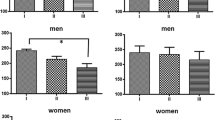Abstract
Changes in heart rate (HR) and blood pressure (BP) in advanced male meditators during 1 hr of meditation were compared with matched control participants resting for 1 hr. Also, changes in HR and BP during 3-hr meditation were analyzed. HR was recorded continuously during meditation (n = 38) and the control rest (n = 21). BP was measured before and after the meditation (n = 44) and the rest (n = 30). During the first hour, HR declined more in the meditators than the controls (p < .01). Within participant variability of HR was significantly lower during meditation than rest (p < .05). In the second hour of meditation, HR declined further (p = .01). BP was unaffected by either meditation or rest. In conclusion, meditation reduced the level of HR and within participant variability of HR more than rest. HR continued to decline during the second hour of meditation.
Similar content being viewed by others
REFERENCES
Alexander, C. N., Schneider, R. H., Staggers, F., Sheppard, W., Clayborne, B. M., Rainforth, M., et al. (1996). Trial of stress reduction for hypertension in older African Americans: II. Sex and risk subgroup analysis. Hypertension, 28 ,228–237.
Barnes, V. A., Treiber, F. A., & Davis, H. (2001). Impact of Transcendental Meditation (⊥) on cardiovascular function at rest and during acute stress in adolescents with high normal blood pressure. Journal of Psychosomatic Research, 51 ,597–605.
Barnes, V. A., Treiber, F. A., Turner, J. R., Davis, H., & Strong, W. B. (1999). Acute effects of transcendental meditation on hemodynamic functioning in middle-aged adults. Psychosomatic Medicine, 61 ,525–531.
Delmonte, M. M. (1984). Physiological responses during meditation and rest. Biofeedback and Self Regulation, 9 ,181–200.
Dillbeck, M. C., & Orme-Johnsen, D. W. (1987). Physiological differences between Transcendental Meditation and rest. American Psychologist, 42 ,879–881.
Eisenberg, D. M., Delbanco, T. L., Berkey, C. S., Kaptchuk, T. J., Kupelnick, B., Kuhl, J., et al. (1993). Cognitive behavioral techniques for hypertension: Are they effective? [See comments] Annals of Internal Medicine, 118 ,964–972.
Hansson, L., Zanchetti, A., Carruthers, S. G., Dahlof, B., Elmfeldt, D., Julius, S., et al. (1998). Effects of intensive blood-pressure lowering and low-dose aspirin in patients with hypertension: Principal results of the Hypertension Optimal Treatment (HOT) randomised trial. HOT Study Group [see comments]. Lancet, 351 ,1755–1762.
Holmes, D. S. (1984). Meditation and somatic arousal reduction. A review of the experimental evidence. American Psychologist, 39 ,1–10.
Holmes, D. S., Solomon, S., Cappo, B. M., & Greenberg, J. L. (1983). Effect of Transcendental Meditation versus Resting on Physiological and Subjective Arousal. Journal of Personality and Social Psychology, 44 ,1245–1252.
Kaplan, N. (1994). Clinical hypertension (6th ed.). Baltimore: Williams & Wikins.
Kristal-Boneh, E., Silber, H., Harari, G., & Froom, P. (2000). The association of resting heart rate with cardiovascular, cancer and all-cause mortality. Eight year follow-up of 3527 male Israeli employees (the CORDIS Study). [See comments] European Heart Journal, 21 ,116–124.
Morcet, J. F., Safar, M., Thomas, F., Guize, L., & Benetos, A. (1999). Associations between heart rate and other risk factors in a large French population. Journal of Hypertension, 17 ,1671–1676.
Murphy, M. D. S. (1997). The physical and psychological effects of meditation. A review of contemporary research with a comprehensive bibliography 1931–1996. Taylor, E., 2 Ed. 1-286. Sausolito: Institute of Noetic Sciences.
Patel, C., Marmot, M. G., & Terry, D. J. (1981). Controlled trial of biofeedback-aided behavioural methods in reducing mild hypertension. BMJ, 282 ,2005–2008.
Patel, C., Marmot, M. G., Terry, D. J., Carruthers, M., Hunt, B., & Patel, M. (1985). Trial of relaxation in reducing coronary risk: Four year follow up. BMJ, 290 ,1103–1106.
Peng, C. K., Mietus, J. E., Liu, Y., Khalsa, G., Douglas, P. S., Benson, H., et al. (1999). Exaggerated heart rate oscillations during two meditation techniques. International Journal of Cardiology, 70 ,101–107.
Pollard, G., & Ashton, R. (1982). Heart rate decrease: A comparison of feedback modalities and biofeedback with other procedures. Biological Psychology, 14 ,245–257.
Reunanen, A., Karjalainen, J., Ristola, P., Heliovaara, M., Knekt, P., & Aromaa, A. (2000). Heart rate and mortality. Journal of Internal Medicine, 247 ,231–239.
Schneider, R. H., Staggers, F., Alexander, C. N., Sheppard, W., Rainforth, M., Kondwani, K., et al. (1995). A randomised controlled trial of stress reduction for hypertension in older African Americans. Hypertension, 26 ,820–827.
Silverberg, D. S. (1990). Non-pharmacological treatment of hypertension. Journal of Hypertension Supplement, 8 ,S21–S26.
Solberg, E. E., Berglund, K. A., Engen, O., Ekeberg, O., & Loeb, M. (1996). The effect of meditation on shooting performance. British Journal of Sports Medicine, 30 ,342–346.
Solberg, E. E., Halvorsen, R., & Holen, A. (2000). Effect of meditation on immune cells. Stress Medicine, 16 ,185–190.
Joint National Committee. (1997). The sixth report of the Joint National Committee on prevention, detection, evaluation, and treatment of high blood pressure. [See comments] Archives of Internal Medicine, 157 ,2413–2446. [published erratum appears in Arch Intern Med 1998 Mar 23;158(6):573]
Throll, D. A. (1982). Transcendental medication and progressive relaxation: Their physiological effects. Journal of Clinical Psychology, 38 ,522–530.
Wallace, R. B. H. (1972). The physiology of meditation. Scientific American, 226 ,85–90.
Wøien, G., Øyen, O., & Graff-Iversen, S. (1997). 22 år med hjerte-og karundersøkelser i norske fylker. Bør vi være tilfreds med den utviklingen risikofaktorene har hatt? Norsk Epidemiologi, 7 ,255–266.
Author information
Authors and Affiliations
Corresponding author
Rights and permissions
About this article
Cite this article
Solberg, E.E., Ekeberg, Ø., Holen, A. et al. Hemodynamic Changes During Long Meditation. Appl Psychophysiol Biofeedback 29, 213–221 (2004). https://doi.org/10.1023/B:APBI.0000039059.20738.39
Issue Date:
DOI: https://doi.org/10.1023/B:APBI.0000039059.20738.39



